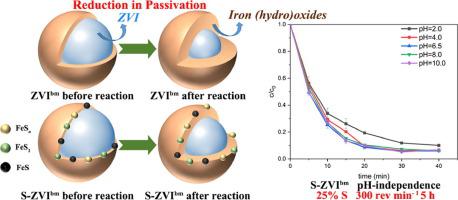Chemical Engineering Journal ( IF 13.3 ) Pub Date : 2021-05-08 , DOI: 10.1016/j.cej.2021.129789 Shanshan Deng , Liquan Liu , Giovanni Cagnetta , Jun Huang , Gang Yu

|
Surface passivation and an increase in pH may restrain the efficiency and capacity of the zero-valent iron (ZVI) activated persulfate (PS) process. Mechanochemically sulfidated ZVI (S-ZVIbm) shows an extraordinary increase in the activation of PS. Ball-milling avoids the complex liquid reactions of traditional methods of activation and is easier to upscale. However, the effects of the sulfur dose and milling conditions have not been sufficiently investigated in the application of S-ZVIbm to the PS activation process. S-ZVIbm was pH-independent compared with similar catalysts. The best performance was obtained for S-ZVIbm with 25% sulfur synthesized at 300 rev min−1 for 5 h. Almost complete degradation of 50 μM ATZ was obtained after 40 min reaction with 6 mM PS and 0.3 g L-1 S-ZVIbm. Structural and species characterizations revealed the effects of the milling conditions and showed that sulfide (S2−) might be the predominant sulfur species. The primary facilitation mechanisms of S-ZVIbm were the mitigation of passivation, an increase in hydrophobicity, an increase in electron transfer and the accelerated regeneration of Fe2+. 57Fe Mössbauer spectrum confirmed that the Fe0 left in S-ZVIbm was about two times higher than that in reacted ZVIbm. Fe0 acted as the predominant PS activator, but FeS2, FeS and SO32− also contributed to PS activation. The degradation pathway of atrazine was clarified based on the detection of intermediates and density functional theory calculations. S-ZVIbm is a promising catalyst for the activation of PS used to remediate refractory contaminants and is amenable to upscaling from the laboratory scale.
中文翻译:

机械化学合成的S-ZVI bm复合材料,用于过硫酸盐在不依赖pH的阿特拉津降解中的活化:硫剂量和球磨条件的影响
表面钝化和pH值升高可能会限制零价铁(ZVI)活化过硫酸盐(PS)工艺的效率和容量。机械化学硫化的ZVI(S-ZVI bm)显示PS的活化异常增加。球磨避免了传统活化方法的复杂液体反应,并且更易于规模化。但是,在将S-ZVI bm应用于PS活化过程中,尚未充分研究硫剂量和研磨条件的影响。与类似的催化剂相比,S-ZVI bm不依赖于pH。对于S-ZVI bm而言,以300转/分钟-1合成的25%硫获得了最佳性能持续5小时。与6 mM PS和0.3 g L -1 S-ZVI bm反应40分钟后,几乎可以完全降解50μMATZ。结构和物种特征揭示了研磨条件的影响,并表明硫化物(S 2−)可能是主要的硫物种。S-ZVI bm的主要促进机制是钝化的减轻,疏水性的增加,电子转移的增加以及Fe 2+的加速再生。57 FeMössbauer光谱证实,S-ZVI bm中剩余的Fe 0约为反应ZVI bm中的Fe 2。铁0充当了主要的PS活化剂,但FeS 2,FeS和SO 3 2-也是促成PS活化的原因。基于中间体的检测和密度泛函理论的计算,阐明了r去津的降解途径。S-ZVI bm是一种用于活化PS的催化剂,可用于修复难处理的污染物,并且可以从实验室规模进行升级。

































 京公网安备 11010802027423号
京公网安备 11010802027423号